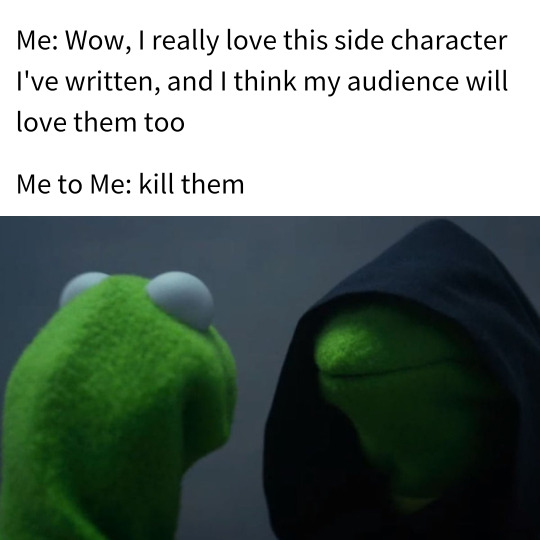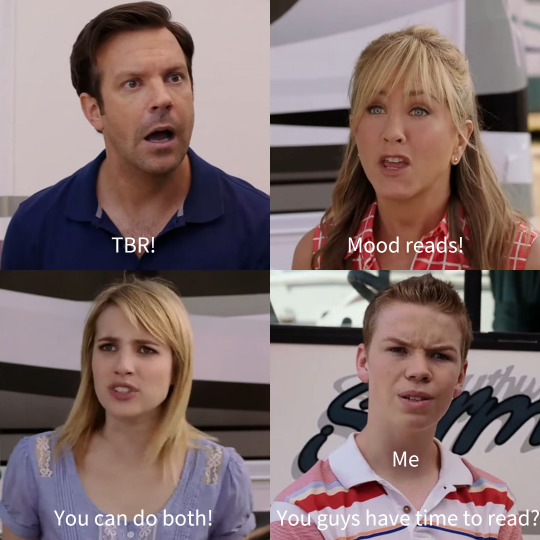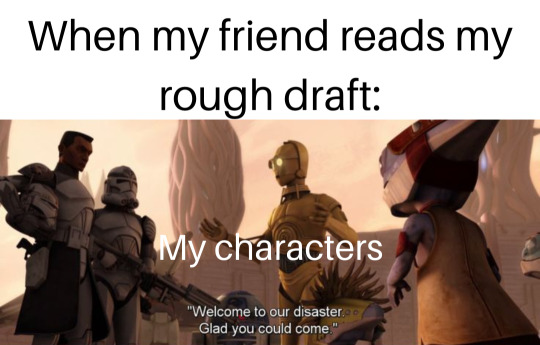Text
Questions I Ask My Beta Readers
"Did you like it?" just doesn't cut it when you're trying to get useful feedback, so here's some questions that get your reader really thinking about your work:
What are your general impressions after reading? How did you feel when the book ended?
(For fantasy/sci-fi) What did you find most confusing about the world? What did you find the most interesting? What do you want to know more about?
Were there any scenes that broke your suspension of disbelief? Which ones? Why?
Which chapters were the hardest to get through? Did you find yourself skimming the text at any point in the story?
Which character was your favorite? Which was your least favorite? Why? (Note that this question is best when asking multiple readers. If one person really dislikes a character, it could be personal preference. If multiple people can't stand a character for the same reason.... well, that's a problem you need to fix. Unless, of course, you want your readers to hate that character. Just make sure that their hatred enhances the reading experience instead of ruining it).
Did you get any characters confused or mixed up? If so, did this make the story hard to follow?
What was the most suspenseful moment in the book? What was your favorite moment of the story? What was your least favorite moment in the story? Why?
Which setting in the book was clearest to you as you were reading it? Which setting was the most difficult to envision?
Did you feel there was a lot of info dumping at any point? If so, where?
How do you feel about the plot? Were there any parts that confused you or seemed nonsensical/ illogical?
Did you feel any part of the story was predictable? Do you have any predictions for the next book(s)? If so, what are they? (Again, another question that's best when asking multiple readers. Be aware of your audience here. Some people, especially those who read a lot, are really good at predicting where stories are going to go. If those people are able to guess what happens next, that might actually be a good thing, because it could indicate that your story is progressing logically. Too much predictability is a problem, but a little isn't bad. This question is just to make sure the plot twists/progression aren't painfully obvious to most readers).
What plot holes did you find in the story so far?
Were you invested in the story? If so, at what point did you become invested? Did you lose this interest at any point? (The second point here is really good for determining whether you have a slow beginning. Sometimes readers might really like your story overall, but would not have gotten past the first few chapters if they were reading it for fun instead of as a favor for you. This happened to me last time I asked someone to read my work, and it made it clear how much of the beginning I needed to rewrite entirely).
Any other questions or comments?
2K notes
·
View notes
Text

Changing it up with a teacher meme today because I spent all weekend grading papers😅
#avatar the last air bender memes#avatar#avatar the last airbender#zuko#that's rough buddy#memes#meme monday#teacher#teacher memes#grading#grading papers
22 notes
·
View notes
Text

Yes...but also no😅
#writing#meme monday#author#writers#writerslife#writing memes#author meme#writer memes#wip#writer problems#internal screaming
6 notes
·
View notes
Text

#writing#meme monday#author#writers#writerslife#writing memes#author meme#writer memes#writer problems#emperors new groove#wip#pacha meme#emperors new groove meme
13 notes
·
View notes
Text

#reader life#meme monday#reading memes#reader memes#reader problems#books#reading#reading ocd#ocd#mood#the struggle is real#my life
6 notes
·
View notes
Text

My writing style involves killing all your favorite characters and still calling it a happy ending😅😈
#writing#author#meme monday#writers#writerslife#writing memes#author meme#writer memes#wip#writer problems#killing characters#character death#happy ending#HEA
3 notes
·
View notes
Text

#meme monday#author#writing#writers#writerslife#writing memes#author meme#writer memes#writer problems#author problems#among us#among us memes#emergency meeting#character death#killing characters
13 notes
·
View notes
Text

#writing#author#meme monday#writers#writerslife#writing memes#author meme#writer memes#writer problems#wip#author life#author problems#evil kermit#character death
350 notes
·
View notes
Text

#bookstore#meme monday#book memes#bookstore memes#this song will be in my head all day#bet on it#hold up#high school musical 2#high school musical memes#zac efron#reader memes#reading#readers
10 notes
·
View notes
Text

2 notes
·
View notes
Text
#crazy comma lady#commas#writing#wip#editing#copy editing#meme monday#yzma#yzma cat#emperors new groove
0 notes
Text
#meme monday#reading#reading memes#books#book friends#will and grace#will and grace memes#jack mcfarland#just jack
1 note
·
View note
Text

#reader life#readers#reading#reading memes#reader memes#tbrstack#tbr#mood reads#mood reader#literally how do you guys do it#meme monday#you guys are getting paid
6 notes
·
View notes
Text

#writing#author#writers#writerslife#writing memes#author meme#meme monday#writer memes#writer problems#rough draft#rough draft memes#clone wars#clone wars memes#welcome to our disaster
27 notes
·
View notes
Text
Show Don't Tell: Anger
Greetings, lovely people! It's great to be back with another post in my 'Show Don't Tell' series! I hope you've all been doing well. Without further ado, let's dive right into today's topic: anger.

Anger is a powerful and complex emotion that can manifest in many ways. It can range from a mild irritation to a full-blown rage, and can be triggered by a variety of factors, including frustration, injustice, or hurt. While it's natural to want to avoid anger in our personal lives, it can actually be a useful tool when it comes to creative writing.
When it comes to writing, anger can add depth and complexity to characters and their interactions. By showing a character's anger, we can reveal their motivations, values, and flaws, and create a more dynamic and realistic portrayal of human emotion. Additionally, anger can create tension and conflict in a story, driving the plot forward and keeping readers engaged.
But hey, I'm not here to talk about the nitty-gritty of anger. I'm here to help you learn how to effectively show your character's anger in your writing! So let's dive right in, starting with the powerful tool of body language.
Clenched fists
Tightly crossed arms
Stiff or rigid posture
Facial expressions like frowning, scowling, or furrowing their brows
Pacing or restlessness
Grinding teeth or jaw clenching
Aggressive gestures like pointing or shaking a finger
Staring or glaring
Raised voice or shouting
Heavy breathing or sighing
Pounding a fist on a surface
Tightened or bulging neck muscles
Sweating or flushed skin
Looking away or avoiding eye contact
Physical violence, such as hitting or throwing objects
Tensing or flexing muscles
Clenching or unclenching fists repeatedly
Baring teeth or showing a snarl
Raising eyebrows or narrowing eyes
Rolling eyes or making sarcastic facial expressions
Biting or chewing on their lips
Tapping their foot or fingers impatiently
Leaning in aggressively or invading personal space
Hunching over or making themselves appear smaller
Using a monotone or clipped tone of voice
Holding their breath or exhaling loudly
Clapping hands sarcastically or making dismissive hand gestures
Making fists and shaking them at someone
Puffing up their chest or standing tall to appear more imposing
Stomping their feet or making loud footsteps.
Scrunching their nose or flaring nostrils
Puckering or twisting their mouth
Tugging or pulling at their hair or clothing
Crossing or uncrossing their legs or ankles abruptly
Bending or clenching their toes or curling their toes tightly
Bouncing or tapping their knee rapidly
Grinding or rubbing their hands together
Picking at their nails or skin
Covering their face or eyes with their hands
Throwing their head back in frustration or exasperation.
Raising or lowering their voice
Slamming things down too hard that they are carrying.
Pursing their lips and nodding.
Running their tongue on the inside of their cheek.
Stalking instead of walking
Scratching their head or neck vigorously
Pulling or tugging at their ears
Biting their tongue or inside of their cheek
Flinching or tensing up when someone approaches them
Nodding their head sharply or repeatedly
Squeezing or gripping an object tightly, such as a pen or a phone
Slamming doors or drawers
Puffing out their cheeks or blowing air out forcefully
Fidgeting or shifting their weight from foot to foot
Raising one or both eyebrows in surprise or anger.
Shrugging off someone's touch or pushing them away
Curling their lips or sneering
Tilting their head back and closing their eyes
Scrunching up their face in disgust or disapproval
Stomping their foot or kicking an object
Folding their arms tightly across their chest
Clutching their stomach or chest
Rubbing their hands together quickly
Stiffening their body or freezing in place
Turning their back on someone or walking away abruptly.
Making a fist and pressing it into their other hand
Running a hand through their hair in frustration
Holding their hand to their forehead or temple
Biting their lower lip or the inside of their cheek
Tensing their jaw and grinding their teeth
Clenching their fists behind their back or in their pockets
Tugging at their collar or tie
Staring daggers or giving someone a withering look
Curling their toes or flexing their feet
Drumming their fingers or tapping their nails on a surface.
Covering their mouth with their hand and closing their eyes.
Scratching or rubbing the back of their neck
Rubbing their eyes or face vigorously
Putting their hands on their hips and leaning forward
Standing up abruptly or pacing back and forth
Pushing a chair or other object out of the way
Clapping their hands sharply or slamming them on a surface
Breathing heavily or audibly
Hunching their shoulders or shrugging in frustration
There are so many ways to bring your character's anger to life in your writing, and your readers will feel it in their bones! Body language is just one tool in your arsenal, but there are plenty of others to explore. Next up, let's talk about sensory details. While there may be some overlap with body language, there are also unique ways to use sensory details to convey anger.
Sensory details are all about bringing your reader into your character's experience by describing what they feel, see, hear, taste, and smell. But it's not just about surface-level sensations; it's about capturing what your character feels on the inside too. Think about the way anger might make your character's heart race or their vision narrow, or the way it might leave a sour taste in their mouth or make them hyper-aware of certain smells.
Clenched teeth or jaw
Rapid heartbeat or pounding in the chest
Flushed or reddened face
Sweating or clammy skin
Heavy breathing or panting
Muscles tensing or knotting up
Twitching or trembling limbs
Ringing in the ears or muffled sounds
Vision tunneling or blurring
Sensitivity to light or sound
Tingling or numbness in the fingers or toes
Pounding or throbbing headache
Dry mouth or tightness in the throat
Stomach churning or nausea
Tingling or itching sensation on the skin
Increased sensitivity to smells or tastes
Loss of appetite or overeating
Difficulty concentrating or focusing
Racing thoughts or an inability to think straight
Feeling dizzy or lightheaded.
Tense or stiff neck and shoulders
Clammy or shaking hands
Uncontrollable shaking or shivering
Rapid speech or stuttering
Breathy or strained voice
High-pitched or shrill tone
Swelling or throbbing veins
Rapid blinking or eye twitching
Heavy or labored sighs
Chills or goosebumps
Rapid or irregular heartbeat
Flushed or blotchy skin
Pacing or restless movements
Increased energy or restlessness
Headache or pressure in the temples
Chest tightness or discomfort
Dry or sweaty palms
Fidgeting or tapping feet or fingers
Frowning or scowling
Clenching or grinding teeth.
Action is the next layer in showing your character's anger. It's all about capturing the choices they make and the way they interact with their surroundings and other characters while feeling that intense emotion. Maybe they lash out and say things they regret later, or they bottle up their anger and internalize it until it explodes. Maybe they turn to self-destructive behaviors like substance abuse or reckless driving, or they channel their anger into a creative outlet like writing or painting. Whatever actions your character takes, they can reveal a lot about their personality, values, and motivations, and help your readers connect with them on a deeper level.
Yelling or screaming
Throwing objects or slamming doors
Punching or hitting walls
Physically attacking someone
Storming out of a room or location
Refusing to engage in conversation
Passive-aggressive behavior
Giving the silent treatment
Ignoring or avoiding the source of their anger
Interrupting others or talking over them
Criticizing or belittling others
Blaming others for their problems
Making sarcastic or cutting remarks
Engaging in risky behavior or taking unnecessary risks
Excessive drinking or drug use
Engaging in self-harm or other destructive behaviors
Seeking revenge or planning retaliation
Seeking control or power over others
Using manipulation or coercion to get what they want
Betraying or sabotaging others
Withholding affection or love
Sarcasm
Eye-rolling
Mocking or imitating others
Giving ultimatums
Exaggerating or lying about their feelings or experiences
Making threats
Refusing to compromise
Refusing to listen or hear other perspectives.
Getting physically tense or rigid
Clenching their fists or teeth
Biting their nails or lips
Fidgeting or tapping their foot
Pacing back and forth
Making abrupt or sudden movements
Staring or glaring at someone
Crossing their arms or legs defensively
Scratching or rubbing their skin
Crying or showing signs of distress
Withdrawal or isolation from others
Demanding attention or validation from others
Disrupting the peace or harmony in a space or environment
Refusing to follow rules or guidelines
Engaging in arguments or fights with others
Becoming overly competitive or aggressive in their pursuits
Ignoring advice or guidance from others
Showing a lack of empathy or compassion towards others
Being overly critical or nitpicky
Refusing to apologize or take responsibility for their actions.
Exhibiting physical symptoms like sweating or shaking
Making demands or issuing commands to others
Engaging in reckless or dangerous behavior
Becoming overly defensive or argumentative
Engaging in self-destructive behavior or self-sabotage
Refusing to acknowledge or address the source of their anger
Blaming themselves for problems that are not their fault
Seeking out conflict or confrontation with others
Using passive-aggressive behavior to communicate their anger
Engaging in obsessive or compulsive behaviors
Struggling to focus or concentrate due to their anger
Engaging in self-soothing behaviors like rocking or pacing
Using humor to mask or downplay their anger
Becoming distant or disengaged from others.
Now, let's talk about setting. It's not just where your characters are, but how they react to it. This means the environment can be used to show off their anger or even help readers understand why they are feeling angry.
Secluding themselves in a quiet, isolated part of the environment
Moving quickly and aggressively through the environment
Becoming agitated or restless in a peaceful or serene environment
Ignoring or avoiding other characters in the environment
Intentionally damaging the environment or objects within it
Distancing themselves from others or backing away from objects in the environment
Taking actions that disrupt the peace or harmony of the environment, such as slamming doors or turning over tables
Focusing on negative aspects of the environment, such as dirt or clutter, and feeling anger towards those elements
Becoming fixated on a particular aspect of the environment and feeling anger towards anyone who interferes with it.
Avoiding eye contact with others in the environment
Making sarcastic or biting comments about the environment
Displaying impatience or frustration with slow-moving objects or people in the environment
Purposefully choosing a more hostile or uncomfortable location to match their angry emotional state
Remember how a bright, sunny day with chirping birds and fresh flowers can instantly put you in a happy mood? Well, the same goes for the location in your story. Even without a character present, scenery can influence the way readers perceive the mood. So, when it comes to anger, the location can be used to set the tone just as much as the character's actions and emotions.
Weather: Dark clouds, lightning, thunder, and heavy rain can create an ominous and angry atmosphere.
Time of Day: Nighttime or sunset can create a moody and angry atmosphere.
Location: A rundown or dangerous part of town can create a sense of anger or unease.
Objects: Broken or destroyed objects can indicate a character's anger and frustration.
Colors: Dark or vibrant colors like red or black can be used to create a sense of anger.
Noises: Loud, jarring noises like alarms or sirens can create a sense of anger and urgency.
Crowds: A crowded or noisy environment can be used to create feelings of anger or irritation.
Architecture: Cold or sterile environments like hospitals or government buildings can create a sense of anger and frustration.
Nature: A barren or lifeless landscape can create a sense of anger or despair.
Animals: Aggressive or hostile animals can be used to create a sense of danger and anger.
Now, let's talk about dialogue. There's nothing quite like a character yelling and cussing up a storm to show their anger, right? It's one of the most powerful ways to convey intense emotions through words. So, buckle up and get ready to explore the ways in which dialogue can be used to show anger in your writing!
Cursing and using expletives
Speaking loudly and aggressively
Interrupting others and speaking over them
Using sarcastic or mocking tones
Making threats or using violent language
Using short, sharp sentences or phrases
Speaking through gritted teeth or a clenched jaw
Insulting or belittling others
Using repetitive or redundant language
Refusing to engage in conversation or responding with silence.
Using rhetorical questions that are meant to convey frustration
Interrupting themselves mid-sentence with a burst of anger
Repeating a particular phrase or word to emphasize their anger
Using a dismissive tone to indicate irritation or impatience
Speaking with a tone that is icy or cold
Using a monotone voice to convey anger and frustration
Resorting to name-calling or insults
Being defensive or argumentative in their responses
Speaking rapidly and stumbling over their words in their anger
Using a confrontational or challenging tone to express anger.
And what comes after all of that? Well, my dear friend, when you've exhausted their words, body language, senses, and actions, what's left? That's when you dive into their mind and explore their point of view. You can write about their thoughts and inner dialogue to really capture the depth of their anger.
Negative thoughts about others or the situation
Self-criticism and frustration
Dwelling on past events that caused the anger
Increased cynicism and pessimism
A desire for revenge or justice
Difficulty concentrating or focusing on tasks
Racing or intrusive thoughts
A feeling of being overwhelmed or out of control
A sense of injustice or unfair treatment
Blaming others or external circumstances for their anger
Now we come to the last item on our list - metaphors and analogies. They are frequently used in writing to create colorful and vivid descriptions, and can also effectively convey a character's anger. However, it's important to be careful with their use, as readers can become annoyed if they are overused.
"Her anger burned like a wildfire, consuming everything in its path."
"He felt like a coiled snake, ready to strike at any moment."
"Her anger was a thunderstorm, building and brewing until it finally erupted."
"His anger was a ticking time bomb, ready to explode at any second."
"She felt like a volcano, with her anger bubbling just below the surface."
"His anger was a raging river, with powerful currents and dangerous undertows."
"She felt like a caged animal, trapped and helpless in her anger."
"His anger was a sharp sword, cutting through everything in its way."
"She felt like a stormy sea, with her anger churning like the waves."
"His anger was a blazing inferno, burning everything in its wake."
"His anger boiled like lava in a volcano, ready to erupt at any moment."
"Her words sliced through me like a knife, leaving me raw and bleeding with anger."
"He was a ticking time bomb, just waiting to explode with fury."
"Her temper was a wildfire, spreading quickly and uncontrollably."
"His rage was a storm, brewing and building until it unleashed with a violent outburst."
"She was a snake, coiled and ready to strike with venomous anger."
"His fury was a thunderous roar, shaking the very foundations of the earth."
"Her temper was a beast, wild and untamed, impossible to control."
"His anger was a whirlpool, pulling me down into its dark depths."
"She was a volcano, her anger a fiery eruption that left nothing but destruction in its wake."
Well, that's all for today's post. It's always bittersweet to say goodbye, but don't worry, I'll be back soon with more juicy writing tips! Before I go, I'd love to hear your thoughts on this post. Did you find it helpful? Did you learn something new? And more importantly, what other emotions do you want me to tackle next? Let me know in the comments below!
You can find plenty of these posts on my Tumblr, so be sure to check them out! or you can find a more organized version here!
1K notes
·
View notes

